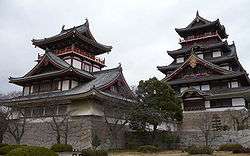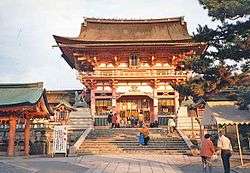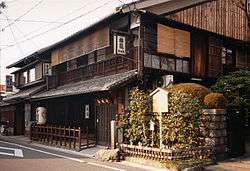Fushimi-ku, Kyoto
| Fushimi 伏見区 | |
|---|---|
| Ward of Kyoto | |
|
Fushimi Momoyama Castle | |
 Location of Fushimi in Kyoto | |
 Fushimi Location in Japan | |
| Coordinates: 34°56′10″N 135°45′41″E / 34.93611°N 135.76139°ECoordinates: 34°56′10″N 135°45′41″E / 34.93611°N 135.76139°E | |
| Country | Japan |
| Region | Kinki (Kansai) |
| Prefecture | Kyoto |
| Founded | 1931 |
| Area | |
| • Total | 61.66 km2 (23.81 sq mi) |
| Population (October 1, 2015) | |
| • Total | 280,655 |
| • Density | 4,600/km2 (12,000/sq mi) |
| Time zone | Japan Standard Time (UTC+9) |
| City hall address |
681 Higashigumi-chō, Fushimi-ku, Kyoto-shi, Kyoto 612-8511 |
| Website |
www |
Fushimi (伏見区 Fushimi-ku) is one of the eleven wards in the city of Kyoto, in Kyoto Prefecture, Japan. Famous places in Fushimi include the Fushimi Inari Shrine, with thousands of torii lining the paths up and down a mountain; Fushimi Castle, originally built by Toyotomi Hideyoshi, with its rebuilt towers and gold-lined tea-room; and the Teradaya, an inn at which Sakamoto Ryōma was attacked and injured about a year before his assassination. Also of note is the Gokōgu shrine, which houses a stone used in the construction of Fushimi Castle. The water in the shrine is particularly famous and it is recorded as one of Japan's 100 best clear water spots.
Although written with different characters now, the name Fushimi (which used to be its own "town") originally comes from fusu + mizu, meaning "hidden water" or "underground water". In other words, the location was known for good spring water. The water of Fushimi has particularly soft characteristics, making it an essential component to the particular type of sake brewed in Fushimi. This also explains why the area developed as a sake-brewing center in Kyoto. Today, Fushimi is the second greatest area of Japan in terms of sake production,[1] and is where the sake company Gekkeikan was founded.[2]
Demographics
| Historical population | ||
|---|---|---|
| Year | Pop. | ±% |
| 1940 | 92,714 | — |
| 1950 | 105,437 | +13.7% |
| 1960 | 135,293 | +28.3% |
| 1970 | 190,569 | +40.9% |
| 1980 | 257,156 | +34.9% |
| 1990 | 280,276 | +9.0% |
| 2000 | 287,909 | +2.7% |
| 2010 | 284,085 | −1.3% |
| 2015 | 280,655 | −1.2% |
| Source: | ||
Economy
The following companies have their headquarters in Fushimi:
- Kyocera, an electronics and ceramics manufacturer[3]
- Murata Machinery, an industrial machines manufacturer[4]
- Gekkeikan, a manufacturer of sake, plum wine, shōchū, mirin, and amazake[5]
- Kizakura, a manufacturer of sake and beer[6]
- Shoutoku, a manufacturer of sake[7]
Education
Ryukoku University, Kyoto University of Education, and Shuchiin University are based in the area.
The ward has a North Korean school, Kyoto Korean Elementary School (京都朝鮮初級学校).[8]
Sights
- Fushimi Inari Shrine – top shrine of largest shrine network in Japan
- Daigo-ji – UNESCO World Heritage site
- Gekkeikan Ōkura Memorial Hall – sake brewing museum
- Fushimi Castle-Toyotomi Hideyoshi's castle in Kyoto; also known as Momoyama Castle, one of the namesakes of the Azuchi-Momoyama Period of Japanese history
- Emperor Meiji Tomb
- Emperor Kammu Tomb
Famous People
- Keiyo Aomatsu - Japanese Nippon Professional Baseball player with the Chiba Lotte Marines of Japan's Pacific League
- Kumi Koda - Singer
- Hideki Okajima - Japanese professional baseball pitcher with the Fukuoka SoftBank Hawks
References
- ↑ Kansai Window - "Japan's number one sake production", retrieved January 24, 2007
- ↑ Gekkeikan (English)
- ↑ "Corporate Summary". Kyocera. Retrieved December 4, 2016.
- ↑ "Outline". Murata Machinery. Retrieved December 4, 2016.
- ↑ "Corporate Outline". Gekkeikan. Retrieved December 4, 2016.
- ↑ "黄桜株式会社(キザクラ・KIZAKURA)". Kizakura co.,ltd. Retrieved December 4, 2016.
- ↑ "SHOUTOKU SHUZO Co.,Ltd.". Shoutoku. Retrieved December 4, 2016.
- ↑ "ウリハッキョ一覧" (Archive). Chongryon. Retrieved on October 14, 2015.
External links
 Media related to Fushimi-ku, Kyoto at Wikimedia Commons
Media related to Fushimi-ku, Kyoto at Wikimedia Commons- Official website (Japanese)




